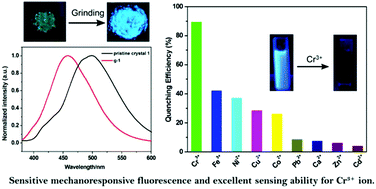Naphthalimide-containing coordination polymer with mechanoresponsive luminescence and excellent metal ion sensing properties†
Abstract
Mechanoresponsive luminescent materials coupled with other functionalities are of particular interest due to their multiple external stimuli responsive properties. In this paper, a new sensitive mechanoresponsive luminescent coordination polymer, [Cd(INI)(DMF)2·DMF] (1) (H2INI = N-(5-isophthalic acid)-1,8-naphthalimide), has been successfully designed and synthesized. Complex 1 exhibits interesting mechanoresponsive and grinding-enhanced luminescence properties, and its luminescence colour changed from weak blue-green to bright blue upon grinding owing to the external pressure-induced destruction of π⋯π stacked arrangements in local defective areas. Moreover, the luminescence properties and uncoordinated carbonyl groups of well-ground g-1 endow it with excellent sensing ability for Cr3+ ions. This work will provide a new perspective to rationally design multifunctional coordination polymers that can serve as practical multi-responsive sensors to pressure and chemicals.



 Please wait while we load your content...
Please wait while we load your content...